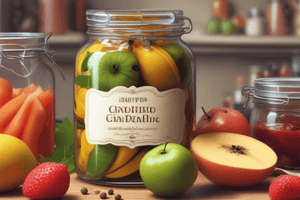Podcast
Questions and Answers
What was the primary purpose of the excavation at George Washington's Mount Vernon home?
What was the primary purpose of the excavation at George Washington's Mount Vernon home?
- To investigate the foundation of the home.
- To preserve the historic mansion. (correct)
- To find historical documents.
- To restore the gardens adjacent to the mansion.
How many bottles were found during the excavation, and what was the condition of these bottles?
How many bottles were found during the excavation, and what was the condition of these bottles?
- 35 bottles, all intact.
- 35 bottles, only 10 were intact.
- 29 bottles, all intact. (correct)
- 29 bottles, some were shattered.
Which type of fruit was found in the preserved bottles?
Which type of fruit was found in the preserved bottles?
- Blackberries and raspberries.
- Apples and pears.
- Cherries and berries, likely gooseberries or currants. (correct)
- Cherries and strawberries.
What insight does the discovery of the preserved fruit provide regarding the Washingtons?
What insight does the discovery of the preserved fruit provide regarding the Washingtons?
Who is primarily responsible for the archaeological findings at Mount Vernon?
Who is primarily responsible for the archaeological findings at Mount Vernon?
What specific analysis were the preserved fruits sent for?
What specific analysis were the preserved fruits sent for?
What was suggested to have aided in the preservation of the cherries found?
What was suggested to have aided in the preservation of the cherries found?
What historical context does the excavation site provide regarding the workforce at Mount Vernon?
What historical context does the excavation site provide regarding the workforce at Mount Vernon?
Flashcards
What was found at Mount Vernon?
What was found at Mount Vernon?
A preserved fruit discovery, found in glass bottles dating back to the 18th century, at George Washington's Mount Vernon home.
When were the bottles likely buried?
When were the bottles likely buried?
The bottles were likely buried under the clay before 1776, likely forgotten after George Washington left for the American Revolution.
How do the bottles help us understand history?
How do the bottles help us understand history?
The preserved fruits from the bottles offer insights into the dietary habits and food preservation techniques of the Washingtons and the enslaved community at Mount Vernon.
What makes this discovery unique?
What makes this discovery unique?
Signup and view all the flashcards
How many bottles were found?
How many bottles were found?
Signup and view all the flashcards
Why were the cherries preserved?
Why were the cherries preserved?
Signup and view all the flashcards
What will scientists do with the cherries?
What will scientists do with the cherries?
Signup and view all the flashcards
What is the goal of the Mount Vernon revitalization project?
What is the goal of the Mount Vernon revitalization project?
Signup and view all the flashcards
Study Notes
18th-Century Fruit Preservation at Mount Vernon
- Archaeologists unearthed 35 glass bottles containing preserved cherries and berries (likely gooseberries or currants) in George Washington's Mount Vernon home cellar.
- The bottles, dating to the mid-1700s, were likely buried before 1776 and forgotten after Washington left for the American Revolution.
- The discovery is part of a $40 million revitalization project at Mount Vernon.
- The preservation of the food is remarkable; nearly 250 years later, the fruit is still intact.
- The bottles originated in England.
- The preserved fruits were carefully sent to USDA scientists for analysis.
- Initial analysis suggests the cherries were a likely tart variety, contributing to their preservation.
Scientific Analysis and Future Research
- The USDA scientists plan to extract DNA from the preserved cherries to identify the exact species.
- This study would provide insights into Virginia's climate change over time.
- Scientists also aim to germinate cherry seeds, potentially creating a living historical artifact.
- The bottles and fruit represent the daily lives of the people at Mount Vernon, including enslaved members of the community.
- The preserved fruit may have been intended for the Washington family but definitely involved people preparing and storing food.
Studying That Suits You
Use AI to generate personalized quizzes and flashcards to suit your learning preferences.
Description
Explore the fascinating archaeological findings of preserved fruits at Mount Vernon's cellar, originally belonging to George Washington. This quiz delves into the significance of fruit preservation techniques used in the 18th century and the ongoing scientific analysis to reveal the implications of climate change over the centuries.




